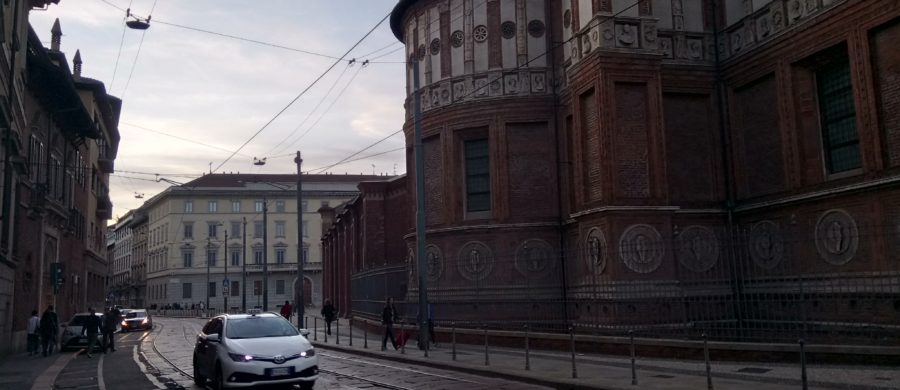
“A Mighty Cobweb”: Electricity, Aesthetics and the Urban Public Space
Technology’s Stories v. 8, no. 1 – DOI: 10.15763/jou.ts.2020.06.08.02
It’s half past 8 on a Friday morning and I’m walking up the hill to work. As I look up, I see the buildings of the university campus ahead of me. The sky is a clear, crisp, wintry blue, and the traffic is heading past me up the one-way street. The environment is highly designed and technologised: from the buses with wifi, to the taxis with satnavs, to the people busily communing with their phones, or wrapped up in a protective digital soundscape, distancing themselves from the muffled noises of the morning rush hour. Everywhere I see sophisticated technological artefacts and systems of transport, communication and power.
But something is notably absent when I look around. At the turn of the twentieth century, this view – the street, the sky – would have looked very different, criss-crossed by wires and cables that prompted some observers, such as the telephone engineer Alfred Rosling Bennett, to refer to them in organic terms as the nervous system of the nation.[1]
Now, the lights go red: the traffic stops. The lights turn green, the flow resumes, a rhythmic and regular pulse. But if I can see the veins and arteries of this urban space, where is its nervous system? Of course, the wires are there, but they are mostly buried underground, hidden, so that we see as little as possible of the inner workings of our electrified lives.
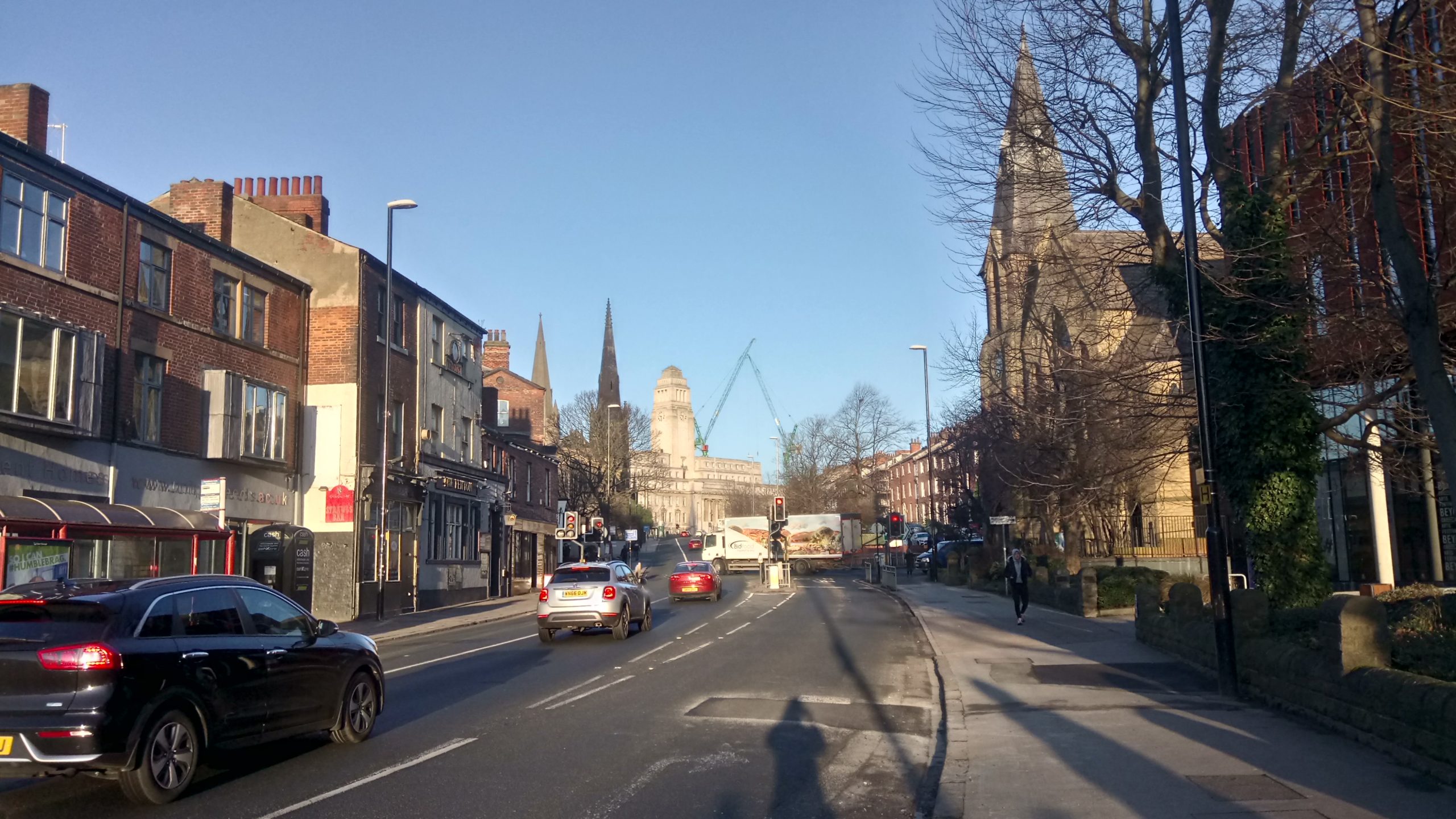
Figure 1. My walk to work. Where are the wires? Photograph by Michael Kay (Leeds, UK, 2020).
This raises several questions: who has the authority to determine what public spaces should look like? What factors or processes shape decisions about which technologies should be deployed in these spaces, and how? And who has a say in this process? Where does the power lie?
This kind of history is very broad, and the history of electrification fits into it as only one important piece of the puzzle. In this article I can only start to raise the questions. But I’d like to begin to address one or two aspects of the answer by exploring the history, and the present, of technologies of telecommunications and electrification in public spaces.
The beginnings of electrification and the transformation of urban spaces
In the late nineteenth century a number of new technologies were beginning to change urban spaces in the UK and around the globe. Streets dominated for centuries by horses, carriages and carts began to be colonised by tramlines, and wires for telegraphy, telephony and electrical light and power.
On the non-electrical side, the riders of increasingly popular bicycles rushed around making pedestrians nervous. And in London, as well as a few other larger cities elsewhere in the world, the overground evidence of underground railways became visible in the form of ventilators for steam and smoke – raising both aesthetic and safety concerns.[2]
There’s no comprehensive study of the aesthetics of electrical infrastructure in the urban public space.[3] Some histories of electrification do discuss aesthetic concerns, but not in the context of infrastructure.[4] However, as technologies of electrification began to transform the urban environments of late nineteenth-century Britain, overhead wires running across roads at all angles in increasing density prompted complaints about their appearance.
In 1885 John Allison, a surveyor in Manchester, noted that two to three thousand wires crossed one street in that city, in all directions. It was, he said, like a web.[5] One local official in Bath referred to the wires there as “a mighty cobweb”.[6] Bath is an old Roman spa town, which relied then, as it does today, on its appearance to attract tourism. So the aesthetics of these new technologies of electrification were of particular concern here. In the City of London one observer noted with distaste that the wires were an eyesore which seemed to darken the air and make the streets hideous.[7]
And it wasn’t just the British who had concerns. Complaints about the aesthetic impact of electrical systems occurred worldwide. In the late nineteenth century New York’s streets were famously laden with electrical infrastructure, heavy with wires and cables.[8] In the 1920s French administrators in Fez, Morocco, at the time a French Protectorate, restricted the spread of unsightly overhead wires in the old city. They sought to preserve a certain historical aesthetic to encourage Western tourism; in this context the new technology was “visually disruptive”.[9] Here, too, wires were compared to spiders’ webs.
Controlling the wires
In 1885, the UK parliament appointed a Select Committee on Telephone and Telegraph Wires to investigate the growing numbers of overhead wires. The committee’s report offers some interesting insights into who had the means and the authority to make decisions in this case.[10]
What it reveals is that the people who were not using these technologies – the majority of the population – felt that they lacked influence because wires could be strung up over the streets for the benefit of a small number of users. But the companies that were doing so also felt that they lacked power. They claimed that firstly they couldn’t put wires underground because, in addition to the expense, there was also a public sentiment against companies digging up and disrupting the roads. And secondly, in a period which upheld the values and virtues of competition, the local authorities didn’t want to permit companies to lay wires underground for fear of promoting a monopoly.[11]
Landowners in London were worried that unsightly wires on or in the vicinity of their properties would reduce their value.[12] Sir George Campbell, a Member of Parliament, related his experience as a homeowner in South Kensington, an area he described as being quite overrun with wires. One passed over his house, but he couldn’t work out where it came from or went to. Assuming for a time that it was abandoned, he considered cutting it down with an axe, but desisted, for fear of killing a child. On one occasion the wire became so slack that he hoped that, as it was repaired, he might learn whose it was. Imagine his consternation when, not only did he not find out who it belonged to, but another one appeared, this one attached to a neighbouring chimney.[13]
Another homeowner told the committee: “There has been one wire carried over my house in the last few days; I do not know how it got there; they do it in the night, I believe. You go to bed and wake the next morning and find a wire over your head.”[14]
However, in addition to this aesthetic discomfort with the introduction of a new technological element into the public space, Allison, in Manchester, noted a very serious potential for accidents: “I was passing along a main street when a wire gave way, and that wire coiled up to the extent of three or four coils, if that had got round any person’s neck it would have been a very serious thing for him.”[15] In Liverpool, Clement Dunscombe, the city engineer and a building surveyor, pointed out that the problem was not the wires themselves breaking, but rather the attachments by which they were fixed to chimneys, roofs and walls. During storms wires could fall down.[16] Some widely reported accidents involving falling wires in the 1880s, involving injury or even death, added safety concerns to visual annoyance.[17]
One unusual exception was Newcastle, where, as the city engineer William George Laws put it: “[T]here are overhead wires existing in Newcastle, but so few that any stranger going through the town would say there were none.”[18] This was because here the local council had insisted from the beginning that the city’s wires were placed underground. Why? Because, he explained, they had seen what had happened in other cities such as London, Liverpool and Manchester, and were keen to avoid the proliferation of overhead wires. Newcastle, said Laws, prided itself on its uniqueness in this respect. However, the Telephone Company, a private concern attempting to compete with the Post Office’s telephone network in the city, claimed that this requirement was choking its business.[19] Although the company might have wanted to run overhead wires around the city, ultimately the final word lay with the local council.
Only a minority of people benefited from these new technologies of telecommunication and electrification, yet everyone saw the unruly tangle of consequences. How did such concerns affect people’s perceptions?
One way in which aesthetic concerns affected the growth of electrical technologies was through problems with obtaining ‘wayleaves’. Wayleaves were the permissions given by those who owned land or property to allow a company to place poles or wires on their property. When these permissions were denied, which happened often, this affected how quickly and cheaply connections could be built within towns and cities.[20]
In 1891, Alfred Bennett – who commented that telegraph and telephone wires were like the national nervous system – highlighted how important it was for wires not to be too unsightly. While debating the relative merits of two different methods of running telephone wires, he argued that one resulted in a much uglier configuration of wires. Bennett noted:
“[t]elephone trunk lines have frequently to be carried past gentlemen’s houses, and across estates. In such cases, as in dealing with road trustees and county councilmen, sightliness is of material moment, as any telephone manager who has to procure wayleaves knows.”[21]
So, because procuring wayleaves required people’s consent, Bennett recommended the neater system. This provides an insight into the ways in which the opinions and complaints of these individuals influenced the technical decisions of engineers.
In response to concerns about wires, a senior representative of one of the larger telephone companies in the 1880s was in favour of educating the public: “There are a great number of nervous people in the world, and you find their nervousness increases just in proportion as their ignorance is dense,” he told the 1885 committee. “These people believe that there is enormous danger connected with the overhead wires. Now experience does not at all confirm that idea, and the public only want to be taught that.”[22] But when faced with resistance from local councils, companies providing overhead wires often had no choice but to capitulate.
The eventual conclusion of the select committee was that the risk to the public from overhead wires had been greatly exaggerated; companies should therefore have the right to pass their wires over people’s property by default, but occupiers had the right to appeal to the local authority to have them removed. However, the elite voices we can hear through the committee’s report also carried a lot of weight, both formally and informally, and as landowners continued to refuse wayleaves, companies continued to struggle. These tensions represent emerging disagreements in this period regarding what public space was for, and what could be done in it.[23]
Modern concerns about the aesthetics of electrification
Although the question of the aesthetics of overhead wires in urban settings is largely a historical one in the West, it is a modern issue in the developing world. For example, many countries such as India, Thailand and Vietnam wrestle with their overhead wiring systems.
Here too observers use imaginative descriptions to emphasise their dissatisfaction with the appearance of these overhead wires. Some recent descriptions include an “impenetrable thicket”[24] in Old Delhi, India, “nightmare knots”[25] in Hanoi, Vietnam, and, perhaps the most striking visual description: “sky spaghetti”[26] in Bangkok, Thailand.
One Nigerian electrician and researcher recently argued that prioritising aesthetics when designing electrical installations in Nigeria is necessary for their acceptance and sustainability.[27] In Thailand, a country which relies heavily on Western tourism, overhead wires often block views of beautiful and historic locations.
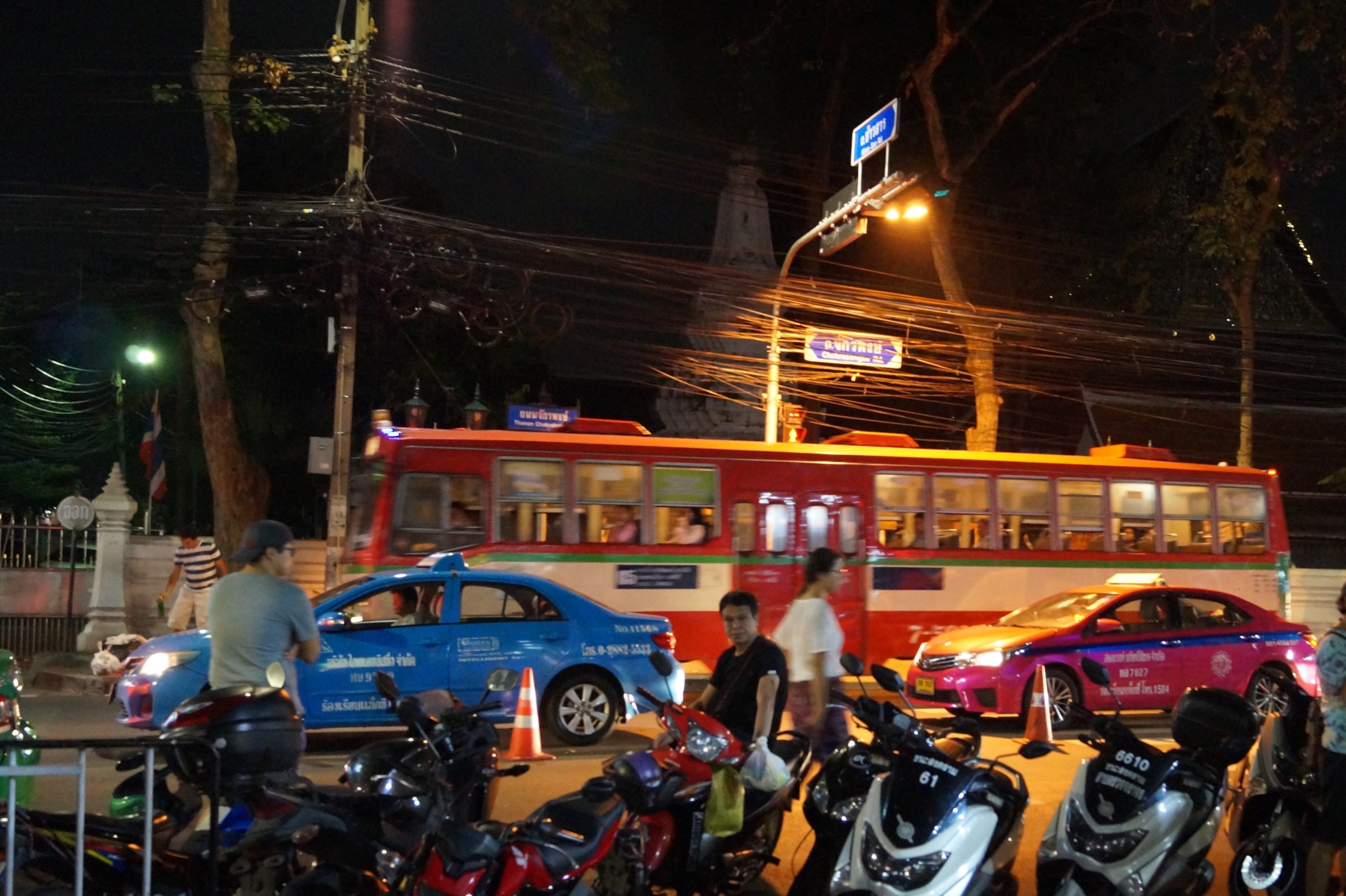
Figure 2. Overhead wires obscure the view of a Buddhist temple in a street in Bangkok, Thailand (2018). Photograph by Jack Kay.
These Anglophone opinions represent a Westernized perspective of what electrified public spaces should look like. But concerns about appearance also go hand in hand with worries about safety. Of course, danger to individuals and property from these wires is less easy to communicate rapidly in an image or in a memorable and amusing metaphor. So perhaps the visual description becomes a proxy, an eye-catching vehicle for the real message.
In terms of driving change, the role of high profile global celebrities might be relevant here: in July 2016, Bill Gates posted on his Facebook an image of overhead wires in Thailand, which he condemned as dangerous.[28] Although Gates’s description of the photograph was inaccurate in its technical details, it served to call attention to the situation. Thai commentators noted that it had prompted the government to respond very quickly, promising action and committing funds – but there is also the sense that Thai people had been complaining about this situation for a long time, with little consequence.[29]
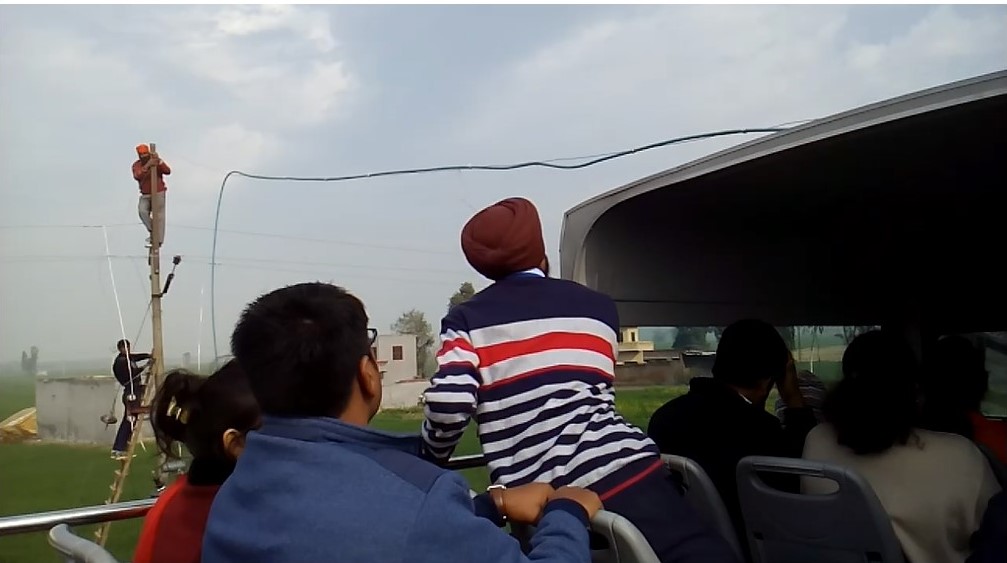
Figure 3. Men lifting a low-hanging cable, passing over a road, so that a bus can drive underneath, in Amritsar, India (2017). Still from a video by Abigail Kay.
Some conclusions: can overhead wires be beautiful?
This exploration raises some broad questions: what can the appearance of systems of electrification, such as the examples given here, tell us about tensions between design or aesthetics, utility, and representation (politically or economically)? How are these tensions negotiated and resolved? This is especially relevant when considering technologies which do not benefit everyone, or which have a small number of users, like early telecommunications or electricity systems, or modern systems in areas of low uptake. In these cases, to what extent might concerns raised about the aesthetics of a technology, for example wires, actually be masking other worries or agendas, such as concerns about the narrowness of use of the technologies in question?
Last year I visited Milan, Italy, where I presented the paper which led to this article. I happened to notice the configuration of the overhead tram wires in the street outside the conference venue. No doubt I was sensitised to this due to the topic of my presentation, but it seemed to me that the wires above almost complemented the street below, and the architecture it boasted. I thought in that moment that the wires contributed positively to the aesthetic, as if they somehow enhanced the view by framing the different aspects of the street: the building shapes and facades, the tramlines, the movement of pedestrians and traffic. It was a strange place to find beauty.[30]
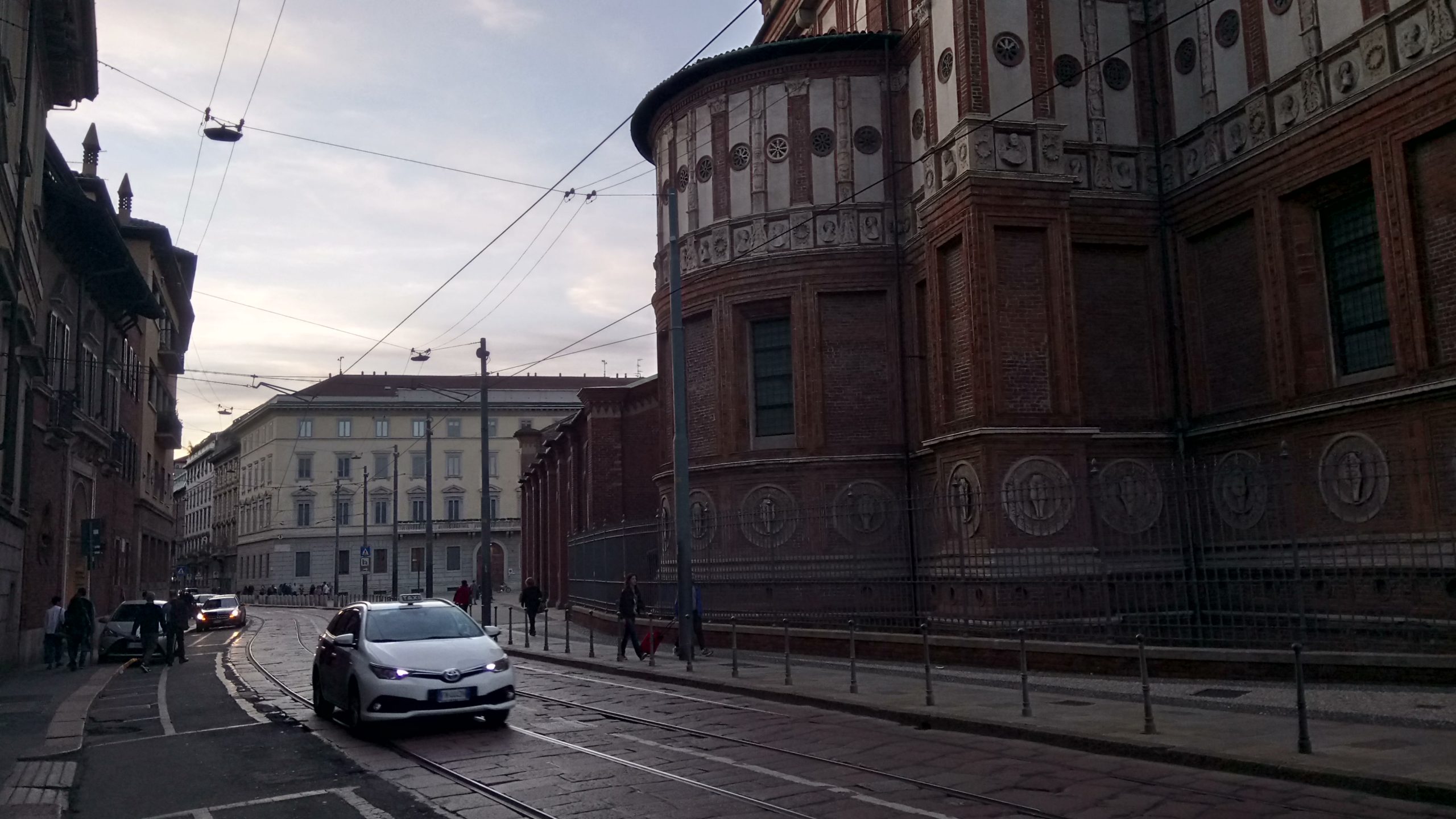
Figure 4. Overhead wires for electric trams in a street in Milan, Italy (2019). Photograph by Michael Kay.
Architects, planners and engineers have always designed and shaped the environment around us, be it the countryside or the cityscape. In the eighteenth century Lancelot ‘Capability’ Brown rose to prominence by designing landscapes to look as if they had not been designed. But at what point do different individuals or groups decide they want to stop and preserve what are inherently human-designed environments, and built landscapes? Which point in time, aesthetically, is chosen as privileged, and why? And who gets the final say in making this decision?
This is a debate that is not only relevant to the history of electrification – it is also relevant to the history, and future, of other large-scale infrastructure technologies, such as transportation and renewable energy. Where the appearance of public spaces is a priority, the aesthetics of the technological systems and artefacts we deploy there may determine their success almost as much as their utility.
Copyright 2020 by Michael Kay
Dr. Michael Kay is a member of the Electrical History Research Group at the University of Leeds, UK. He has published on the history of electrification and telephony, and his current research interests include the history of religious interactions with electrical technologies.
Suggested readings:
- Apelian, Colette. “Modern Mosque Lamps: Electricity in the Historic Monuments and Tourist Attractions of French Colonial Fez, Morocco (1925–1950).” History and Technology 28, no. 2 (2012): 177-207. https://doi.org/10.1080/07341512.2012.694208.
- Gooday, Graeme. Domesticating Electricity: Technology, Uncertainty and Gender, 1880-1914. London: Pickering & Chatto, 2008.
- Gooday, Graeme, and Abigail Harrison Moore. “True Ornament? The Art and Industry of Electric Lighting in the Home, 1889-1902.” In Art Versus Industry? New Perspectives on Visual and Industrial Cultures in Nineteenth-Century Britain, edited by Kate Nichols, Rebecca Wade and Gabriel Williams, 158-78. Manchester: Manchester University Press, 2015.
- Kay, Michael. “Troublesome Telephony: How Users and Non-users Shaped the Development of Early British Exchange Telephony.” Science Museum Group Journal 3 (Spring 2015). http://journal.sciencemuseum.ac.uk/browse/issue-03/troublesome-telephony/.
- Marvin, Carolyn. When Old Technologies Were New: Thinking About Electric Communication in the Late Nineteenth Century. New York: Oxford University Press, 1988.
Bibliography
Anonymous. “Overhead Wires Still Plague Hà Nội.” Viet Nam News, November 13, 2018. https://vietnamnews.vn/society/469486/overhead-wires-still-plague-ha-noi.html#1DvmFZ945lQ89gYX.97.
Apelian, Colette. “Modern Mosque Lamps: Electricity in the Historic Monuments and Tourist Attractions of French Colonial Fez, Morocco (1925–1950).” History and Technology 28, no. 2 (2012): 177-207. https://doi.org/10.1080/07341512.2012.694208.
Barrett, Ken. “Bangkok Grapples with ‘Sky Spaghetti’ in Modernization Push.” Nikkei Asian Review, September 4, 2019. https://asia.nikkei.com/Editor-s-Picks/Tea-Leaves/Bangkok-grapples-with-sky-spaghetti-in-modernization-push.
Bennett, A.R. ‘Twisted Telephone Lines.” Electrician 27 (1891): 85-6.
Boorse, Jack W. and Meade, Monica J. “Context-Sensitive Design Concepts for Streetcar Electrification.” Transportation Research Record: Journal of the Transportation Research Board 2219 (2011): 38–41. https://doi.org/10.3141/2219-05.
Brown, Henry Collins. Book of Old New York. New York: Privately Printed, 1913. Available online: https://archive.org/details/bookofoldnewyork00brow.
Ebenezer, Odji, “Application of Design Principles and Theories for Achieving Optimized Aesthetics in Designs and Electrical Installations.” International Journal of Engineering and Modern Technology 4, no. 8 (2018): 78-93. http://www.iiard.com/index.php/IJEMT/article/view/1149.
Fernquest, Jon. “Tangled Overhead Wires of Bangkok: Bill Gates Concerned.” Bangkok Post, June 28, 2016. https://www.bangkokpost.com/learning/advanced/1021318/tangled-overhead-wires-of-bangkok-bill-gates-concerned.
Gooday, Graeme. Domesticating Electricity: Technology, Uncertainty and Gender, 1880-1914. London: Pickering & Chatto, 2008.
Gooday, Graeme, and Abigail Harrison Moore. “True Ornament? The Art and Industry of Electric Lighting in the Home, 1889-1902.” In Art Versus Industry? New Perspectives on Visual and Industrial Cultures in Nineteenth-Century Britain, edited by Kate Nichols, Rebecca Wade and Gabriel Williams, 158-78. Manchester: Manchester University Press, 2015.
Hall, John. “Danger: 8ft High Voltage!” Daily Mail, August 4, 2015. https://www.dailymail.co.uk/news/article-3185040/Danger-8ft-high-voltage-Lethal-power-cables-dangle-perilously-close-men-women-Old-Delhi-s-no-wonder-poor-electricians-blow-fuse.html.
Hall Ellis, M.J. The Early History of the Telephone in Bath (British Telecom, 1986).
Harrison Moore, Abigail, and Graeme Gooday. “Decorative Electricity: Standen and the Aesthetics of New Lighting Technologies in the Nineteenth Century Home.” Nineteenth-Century Contexts: An Interdisciplinary Journal 35, no. 4 (2013): 363-83. http://dx.doi.org/10.1080/08905495.2013.822687.
Ho, Victoria. “People Are Upset That Bill Gates Mistook Thailand’s Exposed Phone Cables For ‘Power Stealing’.” Mashable, June 27, 2016. https://mashable.com/2016/06/27/bill-gates-thailand-cables.
Hughes, Thomas P. Networks of Power: Electrification in Western Society, 1880-1930. Baltimore: Johns Hopkins University Press, 1983.
Kay, Michael. “Inventing Telephone Usage: Debating Ownership, Entitlement and Purpose in Early British Telephony.” PhD diss., University of Leeds, 2014. Available online: https://ethos.bl.uk/OrderDetails.do?uin=uk.bl.ethos.631397.
Kay, Michael. “Troublesome Telephony: How Users and Non-users Shaped the Development of Early British Exchange Telephony.” Science Museum Group Journal 3 (Spring 2015). http://journal.sciencemuseum.ac.uk/browse/issue-03/troublesome-telephony/.
Marvin, Carolyn. When Old Technologies Were New: Thinking About Electric Communication in the Late Nineteenth Century. New York: Oxford University Press, 1988.
MimiVids. “Think Your Cables Are Messy? Vietnam Powerlines Have Nightmare Knots.” Newsflare, May 8, 2019. https://www.newsflare.com/video/292543/science-technology/think-your-cables-are-messy-vietnam-powerlines-have-nightmare-knots.
Oddy, Nicholas. “This Hill Is Dangerous.” Technology and Culture 56, no. 2 (April 2015): 335-69.
Russell, George William Erskine. “Report from the Select Committee on Telephone and Telegraph Wires.” 1885 (House of Commons Papers, 188) XII.101.
Tortermvasana, Komsan, and Yuthana Praiwan. “After Bill Gates Post, State Moves on Cable Eyesore.” Bangkok Post, June 30, 2016. https://www.bangkokpost.com/business/1023333/after-bill-gates-post-state-moves-on-cable-eyesore.
Notes
[1] Marvin, When Old Technologies Were New, 141.
[2] On bicycles: Oddy, “This Hill Is Dangerous.” For discussions about underground railway ventilators raised in the House of Lords and House of Commons, see: Hansard, “Metropolitan District Railway. Resolution,” HL Deb, 12 March 1883, vol. 277 cc144-55 [available online: https://api.parliament.uk/historic-hansard/lords/1883/mar/12/resolution], and Hansard, “Metropolitan Railways – Ventilators,” HC Deb, 15 March 1883, vol. 277 cc548-9 [available online: https://api.parliament.uk/historic-hansard/commons/1883/mar/15/metropolitan-railways-ventilators].
[3] For the classic study of electrification in this period, see: Hughes, Networks of Power. For some modern engineering perspectives, see: Boorse and Meade, “Context-Sensitive Design Concepts for Streetcar Electrification,” and Ebenezer, “Application of Design Principles.”
[4] For example: Gooday, Domesticating Electricity, Harrison Moore and Gooday, “Decorative Electricity,” and Gooday and Harrison Moore, “True Ornament?”
[5] Russell, “Report from the Select Committee on Telephone and Telegraph Wires”, evidence of John Allison, q.2154-59, 129.
[6] Hall Ellis, The Early History of the Telephone in Bath, 25.
[7] Russell, “Report”, evidence of Lieut.-Colonel William Haywood, q.1446, 86.
[8] Brown, Book of Old New York, 284.
[9] Apelian, “Modern Mosque Lamps”, 185.
[10] Russell, “Report”.
[11] Kay, “Inventing Telephone Usage”, ch. 3.
[12] Russell, “Report”, evidence of Frederick Halsey Janson, 151-3.
[13] Russell, “Report”, evidence of Sir George Campbell, 162-3.
[14] Russell, “Report”, evidence of Sir Arthur Hobhouse, q.1665, 101.
[15] Russell, “Report”, evidence of John Allison, q.2206, 131.
[16] Russell, “Report”, evidence of Clement Dunscombe, q.2257-58, 134.
[17] Kay, “Inventing Telephone Usage”, chapter 3.
[18] Russell, “Report”, evidence of William George Laws, q.2315, 137.
[19] Russell, “Report”, 141.
[20] Kay, “Inventing Telephone Usage”, chapter 3, and Kay, “Troublesome Telephony”.
[21] Bennett, “Twisted Telephone Lines”, 85.
[22] Russell, “Report”, evidence of James Staats Forbes, q.1171, 69.
[23] Russell, “Report”, iii-v. Another aspect of this debate was the aesthetic impact on roads and parks of ventilators for underground railway lines – see: Hansard, “Metropolitan District Railway – The Ventilators on the Victoria Embankment. Question. Observations,” HL Deb, 20 April 1883, vol. 278 cc731-3 [available online: https://api.parliament.uk/historic-hansard/lords/1883/apr/20/question-observati0ns].
[24] Brett Cole, http://www.brettcolephotography.com/media/a0d5c048-6675-480e-ad54-a194dc96fefa-an-inpenetrable-thicket-of-utility-wires-in-the-chandi-chowk-ar. See also: Hall, “Danger: 8ft High Voltage!”
[25] MimiVids. “Think Your Cables Are Messy?” See also: Anonymous, “Overhead Wires Still Plague Hà Nội.”
[26] Barrett, “Bangkok Grapples with ‘Sky Spaghetti’.”
[27] Ebenezer, “Application of Design Principles.” Ebenezer recommends all electrical and engineering practitioners should be trained in aesthetics and design.
[28] Fernquest, “Tangled Overhead Wires of Bangkok.”
[29] Ho, “People Are Upset.” For details of the government’s response, and subsequent developments, see: Tortermvasana and Praiwan, “After Bill Gates Post, State Moves on Cable Eyesore,” and Barrett, “Bangkok Grapples with ‘Sky Spaghetti’.”
[30] For a discussion of the importance of the aesthetics of electric tram systems, see: Boorse and Meade, “Context-Sensitive Design Concepts for Streetcar Electrification.”
